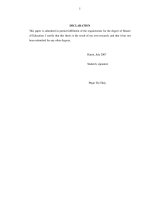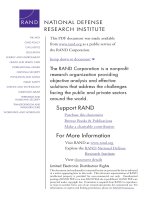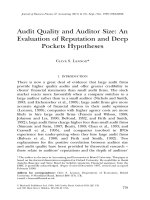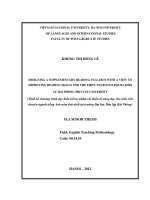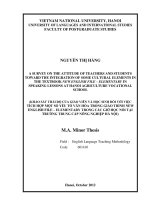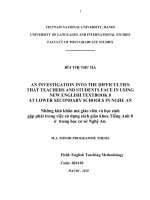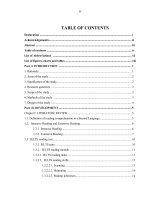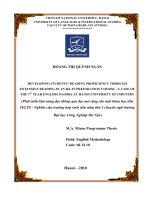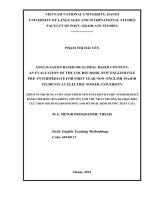An Evaluation of the book Target Pet for the first year non-English majors at Vinh University from the perspective of teachers and students
Bạn đang xem bản rút gọn của tài liệu. Xem và tải ngay bản đầy đủ của tài liệu tại đây (1.5 MB, 110 trang )
MINISTRY OF EDUCATION AND TRAINING
VINH UNIVERSITY
Pham Thi Luong Giang
AN EVALUATION OF THE BOOK “TARGET PET” FOR THE 1
ST
YEAR NON-ENGLISH MAJORS AT VINH UNIVESITY FROM THE
PERSPECTIVE OF TEACHERS AND STUDENTS
Major: Teaching English to Speakers of Other Language (TESOL)
Code: 60 14 01 11
MASTER’S THESIS IN EDUCATION
Supervisor: Nguyen Thi Kim Anh, MA.
Vinh, 2014
i
STATEMENT OF AUTHORSHIP
I certify my authorship of the M. A thesis submitted today entitled:“ An
evaluation of the book Target Pet for 1
st
year non-English majors at Vinh
university” in terms of the statement of requirement for the thesis and the
field study reports in TESOL program has been performed and interpreted
solely by myself, except where otherwise acknowledged and that this minor
or any part of the same had not been submitted for any other form for the
fulfillment of any other degrees or qualifications.
Vinh, August 27, 2014
Author’s signature
Pham Thi Luong Giang
ii
ABSTRACT
The purpose of this study is to evaluate the suitability of the book “Target Pet” to
the non-English majors’ needs, level and learning goals and the requirements of the
course in relation to aims, content, and methodology from the perspective of
students and teachers at Vinh university.
To achieve the above purpose, qualitative and quantitative research methods in
forms of questionnaires, materials analysis are used. In this sequence, the material
in use is analyzed basing on the criteria suggested by Hutchinson and Waters’
(1987) with an aim to determine how the material realizes the course requirements.
A survey on the teachers' and students’ opinions about the extent to which the
material meets the requirements of the course in terms of the aims, content and
methodology is conducted.
Research results have revealed some strengths and weaknesses of the material
which allows the author to conclude that to some extent the book has not fulfilled
the course aims, content and methodology in improving listening and speaking
skills.
Based on the findings, the study offers recommendations on material adaptation
such as addition, deletion, and replacement that should be made to remedy the
weaknesses of the material so that the students can benefit more from it in future
courses.
iii
ACKNOWLEDGEMENT
Many people have helped me complete this thesis. First, I would like to
express my deepest gratitude to my supervisor, Ms. Nguyen Thi Kim Anh, for her
patient guidance, helpful suggestions, encouragement and constructive supervision
in the course of writing this research. Without her help, this work would have been
impossible. My thanks also come to Dr. Tran Ba Tien, the FLD’s Dean, who gave
me the chance and the time to come to the end of this study. I also would like to
acknowledge my gratitude to Ms. Tran Thi Phuong Thao, who has been helpful and
supportive to me during the completion of my thesis. I would like to take this
opportunity to express my thankfulness to all of my English colleagues and students
at Vinh University for their great help and kind cooperation in completing the
questionnaires for the thesis. Finally, my special appreciation goes out to all the
teachers who taught me during the two-year course.
iv
TABLE OF CONTENTS
4.1.1.3. Comments on the material evaluation in term of aims li
Sequence of content lviii
The content of the material does not go from easier to more difficult level. As can be
seen from the organization of content, the material is divided into three parts:
vocabulary, language focus and exam practice. These parts are repeated throughout
the book. Therefore, recycling the learned knowledge is available. Accordingly, it is
reasonable to state that the sequence of content completely fits the course
specification lviii
4.1.2.3 Comments on material evaluation in term of content lviii
4.3. RECOMMENDATIONS FOR MATERIAL IMPROVEMENT lxxviii
5.3. LIMITATIONS OF THE STUDY lxxxiii
5.4. SUGGESTION FOR FURTHER STUDY lxxxiv
REFERENCES lxxxv
APPENDIX 2 VIII
III. Materials X
v
LIST OF FIGURES
REFERENCES lxxxv
vi
LIST OF TABLES
REFERENCES lxxxv
CHAPTER 1
INTRODUCTION
1.1. RATIONALE OF THE STUDY
Course books have a great effect on the process of language teaching and learning
as suitable materials can stimulate effective teaching and learning. Thus, to have a
successful language- teaching program, it is essential to have good course books,
especially in Vietnamese setting.
English has been taught at Vinh University for a long time, and English course
books for non-English majored students have been changed from time to time to be
appropriate for the training objectives as well as the students’ needs. Although
many textbooks are available on the market, it is really difficult to choose the
materials that meet the needs of non-English major students whose English
proficiency is comparatively varied.
In 2008 Vietnam issued Government Decision 1400, the goal of which is: “To
renovate thoroughly the tasks of teaching and learning foreign languages within the
national educational system". Ministry of Education and Training's National
Foreign Language 2020 Project, or Project 2020 for short, was created in 2010 to
implement this national renovation.
Among the objectives of the project is establishing regional foreign language
centers as a major strategy to address teacher development and language teaching
quality throughout the country.
Under Project 2020, Vietnam expects to enable a majority of students to use a
foreign language, especially English, confidently in their study, daily
vii
communication, and work by 2020. According to this project, non-English majored
students when graduating from Vinh university are projected to achieve the third-
highest level of English referring to the Vietnamese Language Proficiency
Framework (6 levels compatible with the Common European Framework). Because
of these reasons, the teachers of English at Vinh University have decided to use the
textbook “Target Pet” for the first year non- English majors in the credit-based
system.
To my best knowledge there has been no research on the course book to examine
how well the materials being in use match the students’ needs and the course
requirements in terms of aims, content and methodology. Therefore, I conduct this
study entitled “An evaluation of the book “Target Pet” for the 1
st
year non-
English majors at Vinh University from the perspective of teachers and students”
with the ambition that it will not only help improve the material’s quality but also
enhance the learning efficiency as well as stimulate students’ interest in language
learning.
1.2. AIMS OF THE STUDY
The aims of the study are as follow:
+ to assess the suitability of the course book to the level and the needs of the
students and the requirements of the course in relation to aims, content, and
methodology from the perspective of students and teachers.
+ to evaluate the effectiveness of the course book in helping the students achieve
the goals and objectives from the perspective of students and teachers.
+ to suggest the material adaptations in responding to the course requirements
and students’ needs.
1.3. RESEARCH QUESTIONS
viii
In order to meet the aims of the study, the following research questions are
generated:
1. How far does the book “Target Pet” match the 1
st
year non - English
majors’ level, needs and the course requirements in relation to aims, content,
and methodology at Vinh university?
2. What adaptations should be made to the book “Target Pet” to make it
more effective in response to the course requirements and the non - English
majors’ needs?
1.4. SCOPE OF THE STUDY
The study is based on Hutchinson and Waters’ (1987) criteria for evaluating the
book “Target Pet” in use for the first year non-English majors at Vinh University
with focus on the three following criteria: aims of the material, content of the
material, and methodology
1.5. ORGANIZATION OF THE STUDY
The thesis consists of the following parts:
Chapter 1. Introduction
This part provides the rationale, the aims, the scope, research questions and
organiztion of the thesis.
Chapter 2: Literature Review and Theoretical Background
Theoretical background related to the topic and surveys of articles, books and other
resources relevant to the study topic will be presented. This part also provides
description, summary, and critical evaluation of each work quoted.
Chapter 3. Methodology
ix
This part presents the detailed procedure of the study: the methodology, population
selection, data collection and analysis.
Chapter 4. Findings and Discussions
The part discusses the findings of the study; points out the strengths and
weaknesses of the book “Target Pet”, and offers the recommendations for the
material supplements and adaptations.
Chapter 5. Conclusion
The conclusion provides a summary of all the major parts being presented in the
study, the conclusions drawn out and suggestions for further research.
x
CHAPTER 2
THEORETICAL BACKGROUND AND LITERATURE REVIEW
The purpose of this chapter is to provide an extensive review of the literature as it
relates to the overall perspectives of language teaching and learning materials
evaluation. Firstly, the theoretical foundations for evaluating language teaching and
learning materials are discussed, including definition of materials in language
teaching and learning, the types of materials in general English courses. Next,
definition of materials evaluation, the role of materials in language teaching, types
and purposes of materials evaluation, materials evaluators, models and criteria for
materials evaluation, and the concept of materials adaption are provided. Presented
in the last part of the chapter is literature review in the world and in Vietnam.
2.1. THEORETICAL BACKGROUND
2.1.1. What are language- learning materials?
A textbook is considered to be one of the major tools for a foreign language
teaching. As textbooks are varied in purposes, it becomes difficult to make accurate
generalization about them. As a result, language practitioners have come up with
their own definition and description of it. According to Tomlinson (2001:66)
language- learning materials are defined as “anything which is used by teachers or
learners to facilitate the learning of a language. In other words, they can be anything
which is deliberately used to increase the learners’ knowledge and/ or experience of
the language”. He supposed keeping this pragmatic concept of materials in mind
can help materials developers to utilize as many sources of input as possible and,
even more importantly, can help teachers to realize that they are also materials
developers and that they are ultimately responsible for the materials that “can be
instructional in that they provide exposure to the language in use, they can be
elicitative in that they stimulate language use, or they can be exploratory in that
they facilitate discoveries about language use” (Tomlinson 2001:66)
xi
Ur (1996), used the term “course book” to refer to a textbook of which the teacher
and usually, each student has a copy, and which is in principle to be followed
systematically as the basis for a language course. Similarly, Hutchinson and Torres
(1994) also consider textbooks as providers of input into classroom lessons in the
forms of texts, activities, explanations and so on. In the same way, Sheldon (1987)
defines “textbook” as a published book whose explicit aim is to assist foreigner
learners of English in improving their linguistic knowledge and/or communicative
ability.
The above mentioned definitions characterize textbooks as a constant companion of
a learner, provider of classroom input, and a generative device for educational
interaction. On the other hand, Grant (1987) categories textbooks as traditional
textbooks and communicative textbooks. The traditional textbook tries to get
students to learn the language as a system. The main emphasis is the forms or
patterns of the language whereas the communicative textbook emphasizes the
communicative functions of the language. Though there are different stances on the
definition of textbooks, it seems that there is no strong position that disregards them
from teaching process. Textbooks are considered to be the most important
ingredients available in a foreign language classroom. Similarly, in the Vietnamese
context, textbooks play a crucial role in a providing a base of materials for both
teachers and students. Most teachers follow at least one textbook as their main
source of guidance in the process of language teaching. Much of language teaching
that occurs through the country could not take place without the extensive use of
textbooks.
2.1.2. Types of Materials
According to Harrison (2002) who is a teacher, teacher trainer and writer of a
number of EFL courses e.g. Better Writing, English Please, and New Headway
Academic Skills, Level 1 (Oxford University Press), teaching materials come in all
xii
shapes and sizes depending on the situation and the intended audience. However,
we can identify two main types:
+ In-house/ Teacher - produced materials
+ Commercial materials
2.1.2.1. In-house materials
They are materials written for and produced by an institution. They are extensive
and usually cover a module or perhaps an entire course. For example, an English
department may decide that their current course book does not give students
adequate writing practice at the right level, so they decide to design a writing
module to go alongside the published course.
2.1.2.2. Commercial materials
There is a certain amount of controversy associated with the use of commercial
materials, particularly course-books. One of the major concerns is that any given
course-book will be incapable of catering the diversity of needs, which exists in
most language classrooms.
Commercial materials (textbooks) are largely produced in various levels, and
available in the market. They can be for general English and English for specific
purposes.
When selecting commercial materials, it is important to match the materials with the
goals and objectives of the program, and to ensure that they are consistent with
one's beliefs about the nature of language and learning, as well as with learners'
attitudes, beliefs and preferences.
Sheldon in Nunan (1991:209) provides an extensive checklist of questions, which
can aid in the selection of commercial materials. He proposes that materials should
be evaluated according to criteria such as their rationale, accessibility, layout and
ease of use. A somewhat more accessible list of evaluative questions is provided by
Breen and Candlin (1987:14-23). Their checklist invites the teacher to adopt a
critical stance toward the materials' aims, appropriateness and utility.
xiii
Furthermore, Littlejohn and Windeatt (1991:209) in Nunan suggest that
commercial materials can be evaluated from six different perspectives: (a) the
general or subject knowledge contained in the materials, (b) views on the nature and
acquisition of knowledge, (c) views on the nature of language learning, (d) role
relations implicit in materials, (e) opportunities for the development of cognitive
abilities, and (f) the values and attitudes inherent in the materials.
Commercial materials, such as the Headway series, Cutting Edge, Business
Objectives, etc, are produced through mainline educational publishers with one or
more authors. Sometimes, authors approach publishers for ideas for textbooks, or
sometimes publishers decide there is a need for a certain type of course and recruit
authors and others to develop the course. Published courses may also develop from
in-house materials.
The use of commercial textbooks in teaching has both advantages and
disadvantages, depending on how they are used and the contexts for their use.
Among the principal advantages are:
- They provide structure and a syllabus for a program. Without textbooks a program
may have no central core and learners may not receive a syllabus that has been
systematically planned and developed.
- They help standardize instruction. The use of a textbook in a program can ensure
that the students in different classes receive similar content and therefore can be
tested in the same way.
- They maintain quality. If a well developed textbook is used students are exposed
to materials that have been tried and tested, that are based on sound learning
principles, and that are paced appropriately.
- They provide a variety of learning resources. Textbooks are often accompanied by
workbooks, CDs and cassettes, videos, CD ROMs, and comprehensive teaching
guides, providing a rich and varied resource for teachers and learners.
xiv
- They are efficient. They save teachers' time, enabling teachers to devote time to
teaching rather than material's production.
- They can provide effective language models and input. Textbooks can provide
support for teachers whose first language is not English and who may not be able to
generate accurate language input on their own.
- They can train teachers. If teachers have limited teaching experience, a textbook
together with the teacher's manual can serve as a medium of initial teacher training.
- They are visually appealing. Commercial textbooks usually have high standards of
design and production and hence are appealing to learners and teachers.
However there are also potential negative effects of the use of textbooks. For
example:
- They may contain inauthentic language. Textbooks sometimes present inauthentic
language since texts, dialogs and other aspects of content tend to be specially
written to incorporate teaching points and are often not representative of real
language use.
- They may distort content. Textbooks often present an idealized view of the world
or fail to represent real issues. In order to make textbooks acceptable in many
different contexts, controversial topics are avoided and instead, an idealized white
middle-class view of the world is portrayed as the norm.
- They may not reflect students' needs. Since textbooks are often written for global
markets they often do not reflect the interests and needs of students and hence may
require adaptation.
- They can deskill teachers. If teachers use textbooks as the primary source of their
teaching leaving the textbook and teacher's manual to make the major instructional
decisions for them the teacher's role can become reduced to that of a technician
whose primarily function is to present materials prepared by others.
xv
- They are expensive. Commercial textbooks may represent a financial burden for
students in many parts of the world.
Both the benefits and limitations of the use of textbooks need to be considered, and
if the textbooks being used in a program are judged to have some negative
consequences, remedial action should be taken, e.g. by adapting or supplementing
books or by providing appropriate guidance and support for teachers in how to use
them appropriately.
Cunningsworth (1995) proposes four criteria for evaluating textbooks particularly
course books:
- They should correspond to learners’ needs. They should match the aims and
objectives of language learning program.
- They should reflect the uses (present of future) which learners will make of the
language. Textbooks should be chosen to enable students to use language
effectively for their own purposes.
- They should take account of students’ need as learners should facilitate their
learning processes, without dogmatically imposing a rigid method.
-They should have a clear role as a support for learning. Like teachers, they mediate
between the target language and the learners.
They feel that it is very difficult for them to teach systematically without textbooks.
Indeed, textbooks play a crucial role in providing a base of materials for both
teachers and students. O’Neill (1982) points out that most teachers are inclined to
follow texts methodology, vocabulary and sequence to letter. There are indeed a
number of advantages of using a textbook. Ur (1996) provides a summary of criteria
in favor of using a coursebook as follows:
xvi
- Framework: a textbook provides a clear framework for teachers and learners to
know where they are going and what is coming next, and build up a sense of
structure and progress.
- Syllabus: in many places, the course book serves as a syllabus. If the syllabus is
followed systematically, a carefully planned and balanced selection of language
content will be made.
- Ready- made texts and tasks: the course book provides texts and learning tasks,
which are likely to be of an appropriate level for most of the class. This of course
saves time for the teacher who would otherwise have to prepare his or her own.
- Economy: a book is the cheapest way of providing learning material for each
learner; alternatives, such as kits, set of photocopied papers or computer software,
are likely to be more expensive relative to the amount of material provided.
- Convenience: A book is a convenient package. It is bound, so its components stick
together and stay in order. Moreover, it is light and small enough to carry around
easily. It is also of a certain shape/ size that is easily packed and stacked. In
addition, it does not depend for its use on hardware or a supply of electricity.
- Guidance: For teachers who are inexperienced or occasionally unsure of their
knowledge of the language, the course book can provide useful guidance and
support.
- Autonomy: The learners can use the course book to learn new material, review and
monitor progress with some degree of autonomy. A learner without a course book is
more teacher- dependent.
However, not everything in the textbook is wonderful (Hammer, 1991). Though the
textbooks are well planned, they can be inappropriate for teachers and students. The
counter-arguments for using textbooks are also listed by Ur (1996) as follows:
xvii
- Inadequacy: In every class, every learner has his/ her own learning needs: no one
textbook can possibly supply these satisfactorily.
- Irrelevance, lack of interest: the topics dealt with in the textbook may not
necessarily be relevant or interesting for any individual class.
- Limitation: a textbook is confining that is, its set structure and sequence may
inhibit a teacher’s initiative and creativity, which leads to boredom and lack of
motivation on the part of the learners.
- Homogeneity: Textbooks have their own rationale, chosen teaching, and learning
approach.
- Over-easiness: Teachers find it too easy to follow the textbook uncritically instead
of using their initiatives; they may find themselves functioning merely as mediators
of its content instead of as teachers in their own right.
In practice, the teacher should take into consideration the given advantages and
disadvantages when choosing a published textbook so as to enhance the strengths
and minimize the weaknesses which might incur in the course of teaching and
learning.
Published textbooks materials offer both good points and bad points, so choosing
which one as a teaching and learning material depends largely on the purposes of
the course as well as the available facilities and constraints of a particular situation.
2.1.3. Roles of teaching materials
Materials are also crucical ingredients in learning the intended curriculum. They are
a media through which teacher and pupils communicate with each other in an effort
to forward the teaching and learning process. The principal advantages of materials
in EFL/ESL classroom forwarded by Richards (2001) and Ur (1996) are:
+ They provide structure and syllabus for a program.
xviii
+ They help standardize instructions.
+ They provide a variety of learning resource.
+ They can provide effective language models and input
+ They provide ready-made texts and tasks.
In most educational systems, the relationship that may exist between teacher,
students and materials is extremely important. To this end, Allwright (1990) asserts
that materials should teach students to learn that they should be resource books for
ideas and activities for instruction and that they should give teachers rationales for
what they do. In addition, Cunningsworth (1995) stated that materials can be used
as guidance for teachers who are inexperienced or occasionally unsure of their
knowledge of the language and as a medium of initial teacher training.
As with all examples in favor of materials, there are also potential negative effects
forwarded by scholars in using materials in EFL classrooms. For instance, Richards
(2001) stipulated that if teachers use textbooks as the primary source of their
teaching, the teacher’s role can become reduced to that of a technician whose
primary function is to present materials prepared by others. Ur (1996) also added
that every learner has their own needs; no single course book can possibly supply
these satisfactorily. For this reason, materials do not usually cater for the variety of
levels of ability and knowledge or of learning styles and strategies that exist in most
classes.
To sum up, the role of the materials in the language classroom is a difficult one to
define perfectly because as Cunningsworth (1984: 6) confirmed no course book will
be totally suited with a particular teaching situation. However, the role of the course
book is to be the service of teachers and learners but not to be their master. So the
relationship between teacher and the material is a partnership which shares common
goals to which each side brings its special contribution. Besides, the aims of the
course book should seek to meet the needs of the learner to the highest degree.
xix
According to Richards (2001) textbooks play a component role in most language
programs. Emphasizing the role of materials, he states that “The teaching materials
can serve as basis for much of language input that the learners receive and as the
source for much of the language practice that occurs in the classroom.”
Richards (2001: 251) further explains that materials provide “basis for the content
of the lesson, balance of skills taught, and the kind of language practice students
take part in.” In other situations, textbooks may be used to supplement the teacher's
instructions. For learners, textbooks may provide a major source of contact they
have with the target language, excluding the input provided by the teacher. In the
case of novice teachers, textbooks may also be utilized as a form of teacher training;
that is, they provide the teachers with ideas on how to plan and teach lessons as well
as with formats that teachers can use. Much of the language teaching that occurs
throughout the world today could not take place without the extensive use of
commercial textbooks. Hence, learning how to use and adapt textbooks is an
important part of a teacher's professional knowledge.
It is true that in many cases, teachers and students rely heavily on textbooks, and
textbooks determine the components and methods of learning, that is, they control
the content, methods, and procedures of learning. Students learn what is presented
in the textbook, and the way the textbook presents material is the way students learn
it. The educational philosophy of the textbook will influence the class and the
learning process. Therefore, in most situations, materials are the center of
instruction and one of the most important influences on what goes on in the
classroom.
According to Nunan (1991), good teaching materials help inexperienced and poorly
trained teachers a lot, but they also help experienced teachers. Theoretically,
experienced teachers can teach English without a textbook. However, it is not easy
to do it all the time, though they may do it sometimes. Many teachers do not have
enough time to design supplementary materials, so they just follow the textbook.
xx
Textbooks, therefore, take on a very important role in language classes. That is also
the reason why the writer chooses one of the materials in use in her university for
evaluation to see if it is appropriate or not to the current teaching circumstance.
2.1.4. Materials evaluation
2.1.4.1. Definitions of Materials Evaluation
There are many ways of defining evaluation. According to Hutchinson and Waters
(1987: 96) materials evaluation is defined as “a matter of judging the fitness of
something for a particular purpose.” Evaluation is, then, concerned with relative
merit. It is neither absolutely good nor bad - only the degree of fitness for the
required purpose is taken into account. Trochim (1989) at Cornel University
supports Hutchinson and Waters (1987) by stating, “evaluation is the systematic
acquisition and assessment of information to provide useful feedback about some
object”. This definition emphasizes “acquiring and assessing information” rather
than assessing worth or merit because all evaluation work involves collecting and
sifting through data, making judgments about the validity of the information and of
inferences we derive from it, whether or not an assessment of worth or merit results.
From the above definitions of evaluation, it can be seen that material evaluation
involves the determination of what needs to be evaluated, the objectives and
requirements of the materials, and the judgments of the value of the materials being
evaluated in relation to the objectives and the requirements determined.
2.1.4.2. Types of Materials Evaluation
It is possible to apply basic principles of material evaluation to all types of
evaluations but it is impossible to make generalization about procedures which
apply to all. Evaluation differs, for example, in purpose, in personnel, in formality
and timing. Grant (1987) and Tomlinson (2003) regard materials evaluation as on
going process and suggest three stages/types of evaluation. They are
1. Preliminary or pre- use evaluation
xxi
2. Formative or in- use evaluation
3. Summative or post- use evaluation
According to Tomlinson (2003), the pre-use evaluation involves making predictions
about the potential value of materials for their users. In order to accomplish this
aim, Grant (1987) purposed a practical test called ‘CATALYST’ simply speaking
the eight letters represents the eight criteria by which we can decide whether a
textbook fits its purpose and the practical needs of the students. For this reasons, the
teacher should shortly ask the key question represented by the word CATALYST.
C Communicative?
A Aims?
T Teachable?
A Available?
L Level?
Y Your impression?
S Students interest?
T Tried and tested?
The in- use evaluation involves measuring the value of materials whilst using them
or whilst observing them. Tomlinson (2003) has listed some basic points that can be
taken in to consideration in an in-use evaluation. These are: clarity of instruction,
clarity of layout, comprehensibility of texts, credibility of tasks, achievability of
tasks, achievement of performance, objectives potential for localization, practicality
of the materials, teachability of the materials, flexibility of the materials, appeal of
the materials, motivating power of the materials and impact of the materials.
Tomlinson (2003) and Grant (1987) stated post-use evaluation is probably the most
valuable (but least administrated) type of evaluation as it can measure the actual
xxii
effect of the materials on the users. Ways of measuring the post-use effect of
materials include: tests of what has been taught by the materials, tests of what the
students can do, examinations, interviews, questionnaires, criterion referenced
evaluation by users, post course diaries, post course reports and etc.
In addition to the above leading scholars, McDonough and Shaw (1993) offer a
working model which they hope will be an effective one to use for teachers working
in a variety of contexts. The models which they suggest is based on the view that it
is useful to perform an external evaluation of materials first in order to gain an
overview of the organization principles involved. After this, teachers can move on
to a detailed internal evaluation of the material in question match up with author’s
claims as well as the aims and objectives of a given teaching program.
The framework by McDonough and Show (1993) suggests that teachers begin with
an ‘external evaluation,’ consisting of an examination of the claims made on the
cover of the students and teachers book, the introduction and the table of contents.
This will help to determine the intended audience, the proficiency level, the context
in which the writers of the materials intend them to be used, the way the language
has been organized into teachable units and the writers view on language and
methodology. In the same taken, Tomlinson (1998) has named this aspect a
publication and relates it to the ‘tangible’ or physical aspects of the materials and
how they appear as a complete set or book.
The second section in the framework, ‘internal evaluation’, requires an in-depth
look at two or more units in order to investigate the presentation of skills in the
materials, the grading and sequencing of the materials, the kinds of texts used and
the relationship between exercises and tests. McDonough and Show (1993).
Taken together, the areas, listed in the framework should provide a comprehensive
coverage of the methodological and content aspects of any set of material. Armed
with such an analytical description of a set of materials, teachers, material
xxiii
designers, educational administrators and, indeed, learners would be in good
position to take decisions about the usefulness and desirability of the materials.
In short, there are different types of materials evaluation so when making an
evaluation, the evaluators have to determine what type of materials evaluation will
be suitable with their work.
As for Vinh University situation, it is the first time the book “Target Pet” has been
used. The researcher decided to use formative/ in–use evaluation with an aim to
determine whether this material is effective or not and offer some recommendations
for further improvements of the material in the future.
2.1.4.3. Purposes of Materials Evaluation
An evaluation of teaching materials helps to identify particular strengths and
weaknesses of the materials in use. After being used in the classroom for a certain
period of time, teaching materials need to be evaluated to see if they have worked
well for the intended situation and students.
According to Ellis (1997), there are two main reasons for carrying out materials
evaluation. Firstly, there may be a need to choose among the materials available the
most suitable ones to use for a particular situation. Secondly, there can be a need for
materials evaluation to determine whether the material, which has been chosen,
works for that situation after it has been used for a period of time. This may help in
deciding whether to use the material again or replace it with a better one.
2.1.4.4. Materials Evaluators
Robinson (1991), Tomlinson (1998), Richards (2001), and Dudley-Evan and St.
John (1998) state that materials evaluators can be either outsiders or insiders.
Outsiders are those who have not been involved in the program such as consultants,
inspectors and administrators. Accordingly, they may not fully understand the
teaching and learning situation in which the evaluation is being carried out. In
xxiv
addition, it may take them more time to be aware of the local situation such as
learners’ needs, facilities and time constraints so it may be difficult for them to
make truly judgments and recommendations of the program.
In contrast to the outsiders, the insiders are those who have been directly involved
in the language-teaching program such as teachers, students, course and materials
designers. Therefore, they can provide the most valid information in the evaluation
process. Also, their understanding of cultural and political factors of the institution
in which the evaluation takes place would enhance the reliability of judgments and
recommendations. To stress the role of the insiders as evaluators, Richard (2001:
296) states that the involvement of the insiders plays an important part in the
success of evaluation because “as a consequence, they will have greater degree of
commitment to acting on its result”. He also adds that the teachers can watch out for
when the materials are being used. Consequently, they can know exactly the extent
that the materials work for their purposes and they can make modifications to
improve the effectiveness of the materials. However, there are also disadvantages to
insiders when they are “too close and involved” (Dudley- Evan and St. John, 1998:
131) so the evaluation may be influenced by their subjective points of view and
their teaching experience.
In short, who will carry out the evaluation, outsiders or insiders, should be
determined according to the purposes of the evaluation. In this research, due to the
limited scope of a thesis, the insiders, especially, the teachers have been chosen as
material evaluators because they have been teaching this material so they
understand clearly about the material, the teaching context and the learners. Their
opinion and their evaluation, therefore, are critical to the improvement of the
material in particular and of teaching and learning in general. Also, the data have
been collected from various sources to minimize the subjectivity of the study.
2.1.4.5. Models for Materials Evaluation
xxv
